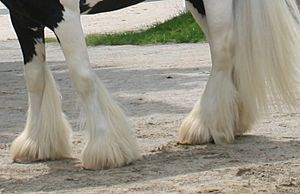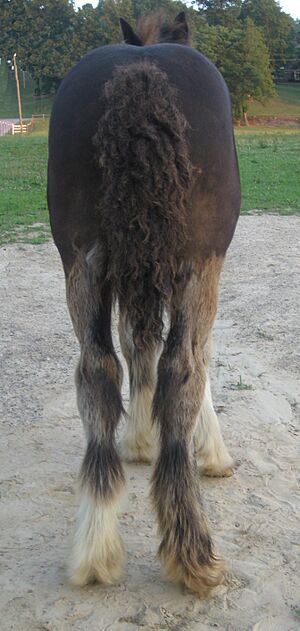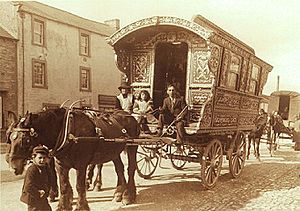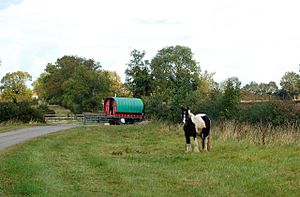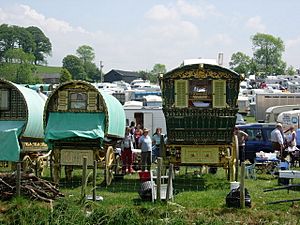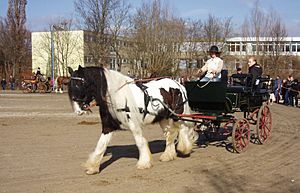Gypsy horse facts for kids
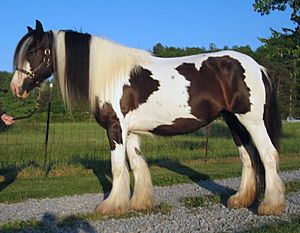 |
|
| Other names |
|
|---|---|
| Country of origin | Ireland, United Kingdom |
| Traits | |
| Distinguishing features | Cob conformation, often piebald or skewbald, feathered heels |
| Breed standards | |
|
|
The Gypsy Cob, also known as the Gypsy Horse or Gypsy Vanner, is a special type of horse. It comes from Great Britain and Ireland. This horse is usually small and strong. It has a "cob" body shape, meaning it's sturdy and compact.
Many Gypsy Cobs have unique coat patterns. They are often piebald (black and white) or skewbald (brown/red and white). These horses are closely linked to the Irish Travellers and English Romanichal Travellers. For a long time, there was no official group to register these horses. But since 1996, the Gypsy Cob is recognized as a breed. You can register them with groups like the Traditional Gypsy Cob Association.
Around 1850, travelling people in the British Isles started using these horses. They pulled their vardos, which are special caravans where they lived and traveled. The look of the breed became more defined after World War II. The first Gypsy Horses were brought to the United States in 1996.
Contents
What Makes a Gypsy Horse Special?
The Gypsy Horse is known for its beautiful look and strong build. Most of them are piebald (black and white). But they can also be skewbald (brown and white) or any solid color. A solid-colored horse with white splashes on its belly is called "blagdon."
Size and Body Shape
There are many groups that register Gypsy Horses. They have slightly different rules for height. In the United States, they are usually between 13 to 16 hands (52 to 64 inches, 132 to 163 cm) hands tall. One hand is about 4 inches. In Europe, some types can be taller, up to 16.2 hands (66 inches, 168 cm) hands.
Some groups have different categories for height. For example, one registry has a Section A for horses under 14.2 hands (58 inches, 147 cm) hands. Section B is for horses 14.2 hands (58 inches, 147 cm) hands and taller.
A special feature of the Gypsy Cob is its feathering. This is the long, silky hair on their lower legs. It's a very pretty part of the horse, but it's not always required for registration.
Head and Neck
A Gypsy Horse's face should be straight, not too curved or bumpy. People like a "sweet" head. This means it's more refined than a typical workhorse. It should have a wide forehead and a strong jaw.
Their neck is strong and muscular. It's medium length. The chest should be broad and deep. The shoulders are usually sloped. The back is short and strong. The belly line should be long. This makes the horse look powerful.
Strong Hindquarters
The back legs of a Gypsy Horse are very strong. This is because they were bred to pull heavy wagons. Their hindquarters are often described as having an "apple butt." This means the back end is very rounded and broad. Weak hindquarters are not wanted in this breed.
Legs and Hooves
The legs should have strong, flat bones. The front legs should be clean and straight. The hooves are strong and round. They have wide heels.
The back legs of the Gypsy Horse are angled outwards. This helps them pull wagons. It's a normal part of their build.
How They Move
Gypsy Horses have special ways of moving. Their walk should be steady and powerful. Their trot (a faster gait) should be smooth. Some horses lift their knees higher than others. Their movement should look natural and easy.
Temperament
Gypsy Horses are known for being very kind and smart. They are willing to work with people. They are also described as polite and easy to manage. They like to please their owners. They are confident, brave, and loyal. They have a friendly nature.
Health Concerns
Gypsy Horses can get some health issues common in feathered horses. One serious condition is chronic progressive lymphedema. This affects their legs. Another less serious issue is pastern dermatitis, also called "greasy heels." This can happen because the feathering keeps the legs moist. This creates a good place for fungus and mites.
History of the Gypsy Horse
The Gypsy Horse was first bred by the Romanichal Travellers in Great Britain. They needed horses to pull their vardos, the wagons they lived in. Romanichal Travellers came to the British Isles around 1500 AD. But they only started living in vardos around 1850. Before that, they traveled in carts or walked.
The peak time for using Gypsy caravans was in the late 1800s and early 1900s. Horses used to pull a vardo were usually very healthy. This was because they got lots of exercise and good care. The horse was seen as part of the family. A horse with a bad temper could not be kept. This was important because children lived so close to the horses.
Gypsy Horses also pulled "tradesman's carts." These were used for work and travel. You can still see examples of these at the annual London Harness Horse Parade.
How the Breed Developed
The Gypsy Horse breed as we know it today started to take shape after World War II. At first, Travellers used any suitable horses or mules to pull their wagons. Later, they started using colored horses. These horses were not popular in mainstream society. Many of them were Shire horses. By the 1950s, these colored horses became very important symbols of status among the Romanichal.
Breeders wanted horses with specific colors, lots of feathering, and strong bones. They also wanted horses that moved well and were a bit smaller. They tried breeding with Hackney Ponies to improve movement. But this reduced the feathering and bone. So, they turned to the Section D Welsh Cob. This helped them get a better trot without losing other desired traits.
Another goal was to make the horses a bit smaller. Larger horses cost more to feed and care for. The Dales Pony was very important in shaping the Gypsy Horse. Dales Ponies are strong and active. They kept the bone, feathering, and pulling ability from the Shire and Clydesdale breeds. But they were smaller and more economical. The Dales and Fell Ponies mixed with Shires and Clydesdales formed the basis of today's Gypsy Horse.
Famous Horses and Registries
The Romani people passed down horse information by talking, not writing. So, details about the first important horses are mostly stories. Two famous founding fathers of the breed are said to be The Old Coal Horse and Sonny Mays' Horse. The breed's origins seem to be Irish. The name Connors is often mentioned in its history.
The Irish Cob can be traced back to the 1700s. It was also considered a type, not a breed. It was used for farm work and riding. It came from mixing Thoroughbred, Connemara pony, and Irish Draught horses.
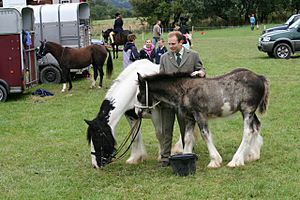
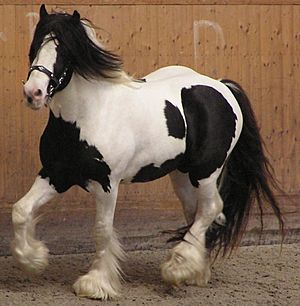
Since 1996, many groups have formed to register Gypsy Horses. These groups are in North America, Europe, Australia, and New Zealand. The first Gypsy Horses came to America in 1996. They were imported by Dennis and Cindy Thompson. They created the name "Gypsy Vanner" and started a breed society.
Names for the Gypsy Horse
The breed was traditionally called the Irish Cob. It was often just called a "Cob." But "cob" is a type of horse, not a specific breed. Other names for the breed are used around the world. These include Gypsy Cob, Gypsy Vanner, and Tinker Cob. These names show its connection to the travelling community.
When Dennis and Cindy Thompson brought the first Gypsy Horses to North America, they thought the breed didn't have a name. So, they chose "vanner." A "vanner" is a light workhorse that pulls vans or buses. This term has been used since at least 1888.
Later, other groups formed. They used names like Irish Cob, Gypsy Cob, and Gypsy Horse. The Gypsy Horse Association recognizes all these names. Some groups in Europe use the names "Tinker Horse" and "Tinker Pony."
Registering a Gypsy Horse

There are many groups that register Gypsy Horses. They offer different services. Some groups have height classifications in their records. Some provide online access to DNA markers and photos of registered horses. This helps verify their identity.
Since Gypsy Horse registration is fairly new, most groups require a genetic analysis for registration. This helps confirm who the parents are. The University of Kentucky helps with DNA analysis for many American groups. They keep a database of the horses' DNA markers. This helps confirm parentage.
Many horses imported to North America didn't have clear family histories. So, owners want to find their horses' genetic roots. Services help with this. American groups often evaluate horses for registration using photos and import papers.
Some groups have specific rules for registration. For example, one group started requiring horses to be sired by registered stallions. Their mothers must also have DNA markers that confirm parentage. Horses must also be within a certain height range. Other groups require horses to pass an inspection to be registered.
How Gypsy Horses Are Used Today
Gypsy Cobs are shown and traded at traditional horse fairs. The Appleby Horse Fair in Europe is the largest. Many Travellers and Romani travel to this fair in their traditional horse-drawn caravans. Photographers have documented these journeys.
In North America, the first shows for Gypsy Horses were held in 2004. The first breed-specific show was in 2005. Now, there are many shows for Gypsy Horses in the US and Canada.
In the United States, Gypsy Horses are used in many horse sports. Amateurs and young people enjoy riding them. The United States Dressage Federation accepts Gypsy Horses in its events. This allows them to compete in dressage and related activities.
Gypsy Horses in Movies and TV
Gypsy Horses have appeared in popular TV shows!
- In the Netflix series "Free Rein", a black and white Pinto Gypsy horse named "Bob" is featured.
- In the CBC series "Heartland", a black and white Gypsy Vanner horse named Ophelia appears in Season 13. Georgie decorates a wagon for Ophelia to pull, like a traditional caravan.
Images for kids


